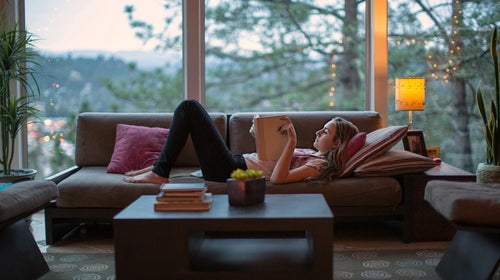For obvious reasons, ║┌┴¤│ď╣¤═° editors arenÔÇÖt used to being inside all the time. But╠řweÔÇÖre working remotely, doing our best to of COVID-19 by avoiding crowds (please do the same!), and making the most of our time at home.
These days, in between ,╠řyouÔÇÖll find us cross-stitching, playing board games, dusting off books that have been on our reading lists forever, and generally trying not to climb the walls.╠řSome of us also╠řgot really excited about , but they havenÔÇÖt╠řwritten╠řabout it (yet).
What WeÔÇÖre Reading
IÔÇÖve been reading Kevin WilsonÔÇÖs novel╠ř, which received rave reviews when it came out last year. It is shockingly relevant to the bizarre, frightening, and poignant moment weÔÇÖre living through. The story follows ten-year-old twins who periodically burst into flames, posing no threat to themselves╠řbut quite a bit to others. The kids are effectively quarantined as they try to exert some control over their affliction. YouÔÇÖll be tempted to fly through these pages, but donÔÇÖt miss how quietly smart WilsonÔÇÖs writing is.
ÔÇöWill Bostwick, editorial fellow
I read , by Rosie Walsh, about a woman who meets a perfect guy and canÔÇÖt figure out why he soon disappears, in just two sittings this weekend. ItÔÇÖs part romance, part mystery, and 100 percent distraction for these trying times.╠ř
ÔÇöKatie Cruickshank, senior digital marketing manager
Weeks at home and local libraries shutting down call for some big olÔÇÖ books that can sustain speedy readers. IÔÇÖm about three-fourths of the way through ╠ř(620 pages), by Nathan Hill, a beautifully written novel with biting dialogue about a man investigating his absentee motherÔÇÖs past. Once youÔÇÖre done with that, switch gears and let John McPhee take you on a literary vacation with ╠ř(438 pages), a dense nonfiction book about Alaska that was originally published in 1976. If youÔÇÖre still looking for a challenge, I suggest Edmund MorrisÔÇÖs╠ř (a combined 2,496 pages),╠řa biography that excitedly follows the charismatic leader and noted conservationistÔÇÖs entire life. (It took Morris decades to complete.)╠ř
ÔÇöKelsey Lindsey, associate editor
Even if youÔÇÖre a mystery skeptic like me, now is the perfect time to start Tana FrenchÔÇÖs books, a series of literary murder mysteries that resist the clich├ęs of their genre. French, an American living in Ireland, writes each novel from the perspective of a different Dublin detective, infusing the books with warmth and humor despite their dark subject matter. Consider downloading the audio versions, too: French writes in lush, overflowing prose thatÔÇÖs perfect for reading aloud, and the audiobook narrators do a masterful job. My favorite is , a delightfully implausible tale involving doppelg├Ąngers, murderous graduate students, and an old Georgian house full of secrets.╠ř
ÔÇöSophie Murguia, assistant editor
Last year╠řmy graduate-school adviser recommended Kim Stanley RobinsonÔÇÖs ╠řas a bit of light reading. ItÔÇÖs a 624-page cli-fi tome about life in New York City after apocalyptic floods mostly╠řsubmerge╠řit (yes, this was tangentially related to my thesis).╠řRobinson knows my hometown well enough to be delightfully snarky about its neighborhoods and residents.╠řHe also includes╠řscientific, political, and economic plot points that sound╠řkind of╠řplausible, making this vision of New York CityÔÇÖs future feel uncomfortably real. I never had time to finish it during school, but now I do!╠řAnd thereÔÇÖs no time like the present to catch up on dystopian fiction.
ÔÇöXian Chiang-Waren, associate editor
IÔÇÖve been reading , Jodi Kantor and Megan TwoheyÔÇÖs book about their reporting on Harvey Weinstein. ItÔÇÖs not exactly uplifting, but itÔÇÖs still a welcome distraction from the current╠řnews cycleÔÇöespecially now that Weinstein to 23 years in prison. Even if you followed their reporting closely, thereÔÇÖs so much more backstory in the book about how their investigation came together. (I also ordered some new books from , to make a small contribution during this difficult time. If youÔÇÖre able, you should do the same.)
ÔÇöMolly Mirhashem, digital deputy editor
What WeÔÇÖre╠řListening╠řTo
IÔÇÖve been listening to the wonderful new podcast , produced by (which puts out a╠řregular podcast about art, spiritual science, and community thatÔÇÖs also a great option). ItÔÇÖs hosted by the Irish poet Padraig O╠řTuama, whose brogue was one of the first things I loved about the series, and consists of brief episodes that revolve around a different modern poem. O╠řTuama reads and discusses each one, then offers a story about how it resonates with his own lifeÔÇöso you feel like youÔÇÖre getting to know the poem as well as another person. Finally,╠řhe reads the selection╠řa second time, which often takes on fresh meaning after having╠řbeen parsed. I havenÔÇÖt found a book, film, or podcast IÔÇÖve enjoyed more in 2020.╠ř
ÔÇöTasha Zemke, copy editor
When IÔÇÖm cooped up in the house, my go-to activity is needlework paired with podcasts. Cross-stitch and embroidery are cheap and easy to learn, the process is meditative, and the end result is beautiful. ThereÔÇÖs something for any level of artistic ability: cross-stitch is like paint by numbers, while embroidery is more like drawing (or coloring, if you have a pattern). IÔÇÖm currently working my way through the designs in , but there are books and digital patterns available for every interest (including designs inspired by ). As for podcasts, I recommend , where John Greene rates all sorts of human-related things on a five-star scale; the episode ╠řis a mercifully uplifting place to start.╠ř
ÔÇöMaren Larsen, BuyerÔÇÖs Guide deputy editor
A recent episode of the podcast made me laugh this week when I needed it. ÔÇťThe Case of the Missing HitÔÇŁ follows a manÔÇÖs journey to track down a song from the late nineties╠řthat he distinctly remembers hearing on the radio but canÔÇÖt find on the internet (or anywhere else on the planet).╠řItÔÇÖs a problem weÔÇÖve all hadÔÇöa tune stuck in our heads that we canÔÇÖt remember the name ofÔÇötaken to the extreme. The poor guy tries painstakingly to recreate the song, first at home on GarageBand, then in a recording studio with an actual band. By the end, the mystery earworm will be stuck in your head, too, and youÔÇÖll beg for the conclusion. It wonÔÇÖt disappoint.
ÔÇöClaire Hyman, editorial assistant
What We Watched and Otherwise Experienced
I would honestly take a bullet for any of the characters in , a bighearted six-part documentary series from Netflix about the countryÔÇÖs best cheerleading team: Navarro. The junior college is in rural Texas, and the squad╠řis made up of insanely tough, talented athletes. YouÔÇÖll laugh, youÔÇÖll cry, and you hopefully wonÔÇÖt╠řthink about anything but bows, human pyramids, and national cheerleading championships for a solid six hours.╠ř
ÔÇöAbbie Barronian, assistant editor
I have a deep and long-standing obsession with board games. Throughout college and my adult life, IÔÇÖve been a part of many weekly tabletop game groups. (OK, sometimes more than weekly.) Here are my best recommendations, from simplest to most complex: , (you can play this one alone against an Amazon Alexa), , , , and (a little close to home, sure, but an incredible campaign game if you can handle the topic). If youÔÇÖre solo, pick up and bliss out to the worldÔÇÖs most meditative, joy-sparking game.
ÔÇöJenny Earnest, audience development director
As someone who wasnÔÇÖt a huge Hillary Clinton supporter during the 2016 election╠ř(but still voted for her!), IÔÇÖve really enjoyed the documentary series on Hulu. ItÔÇÖs well shot, well edited, and gives the former First Lady╠řher own voice in setting the record straight about╠řwhat really went down four years ago. Democrat or not, this series is an absolute must-watch.
ÔÇöEmily Reed, video producer
IÔÇÖve also been watching the Hillary Clinton documentary on Hulu, which is divided into four one-hour episodes. ItÔÇÖs fascinating to witness all that went on╠řbehind the scenes of the 2016 election and hear how Clinton, her team, and her family feel about it in hindsight. Everyone interviewed, including Hillary and Bill, is very open. IÔÇÖm two hours in and look forward to more.
ÔÇöMary Turner, deputy editor


